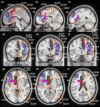Parcellation-based tractographic modeling of the salience network through meta-analysis
- PMID: 35733239
- PMCID: PMC9304834
- DOI: 10.1002/brb3.2646
Parcellation-based tractographic modeling of the salience network through meta-analysis
Abstract
Background: The salience network (SN) is a transitory mediator between active and passive states of mind. Multiple cortical areas, including the opercular, insular, and cingulate cortices have been linked in this processing, though knowledge of network connectivity has been devoid of structural specificity.
Objective: The current study sought to create an anatomically specific connectivity model of the neural substrates involved in the salience network.
Methods: A literature search of PubMed and BrainMap Sleuth was conducted for resting-state and task-based fMRI studies relevant to the salience network according to PRISMA guidelines. Publicly available meta-analytic software was utilized to extract relevant fMRI data for the creation of an activation likelihood estimation (ALE) map and relevant parcellations from the human connectome project overlapping with the ALE data were identified for inclusion in our SN model. DSI-based fiber tractography was then performed on publicaly available data from healthy subjects to determine the structural connections between cortical parcellations comprising the network.
Results: Nine cortical regions were found to comprise the salience network: areas AVI (anterior ventral insula), MI (middle insula), FOP4 (frontal operculum 4), FOP5 (frontal operculum 5), a24pr (anterior 24 prime), a32pr (anterior 32 prime), p32pr (posterior 32 prime), and SCEF (supplementary and cingulate eye field), and 46. The frontal aslant tract was found to connect the opercular-insular cluster to the middle cingulate clusters of the network, while mostly short U-fibers connected adjacent nodes of the network.
Conclusion: Here we provide an anatomically specific connectivity model of the neural substrates involved in the salience network. These results may serve as an empiric basis for clinical translation in this region and for future study which seeks to expand our understanding of how specific neural substrates are involved in salience processing and guide subsequent human behavior.
Keywords: anatomy; parcellation; salience network; tractography.
© 2022 The Authors. Brain and Behavior published by Wiley Periodicals LLC.
Conflict of interest statement
Michael Sughrue is the chief medical officer, co‐founder, and shareholder of Omniscient Neurotechnology. Charles Teo is also a consultant for Aesculap and Omniscient Neurotechnology. Isabella Young is an employee of Omniscient Neurotechnology. No products related to this were discussed in this paper. No other authors report any conflict of interest.
Figures




Similar articles
-
Parcellation-based modeling of the supplementary motor area.J Neurol Sci. 2021 Feb 15;421:117322. doi: 10.1016/j.jns.2021.117322. Epub 2021 Jan 18. J Neurol Sci. 2021. PMID: 33497952
-
A parcellation-based model of the auditory network.Hear Res. 2020 Oct;396:108078. doi: 10.1016/j.heares.2020.108078. Epub 2020 Sep 16. Hear Res. 2020. PMID: 32961519
-
Parcellation-based anatomic modeling of the default mode network.Brain Behav. 2021 Feb;11(2):e01976. doi: 10.1002/brb3.1976. Epub 2020 Dec 18. Brain Behav. 2021. PMID: 33337028 Free PMC article.
-
Dysregulation within the salience network and default mode network in hyperthyroid patients: a follow-up resting-state functional MRI study.Brain Imaging Behav. 2020 Feb;14(1):30-41. doi: 10.1007/s11682-018-9961-6. Brain Imaging Behav. 2020. PMID: 30259292 Review.
-
Human brain mapping: A systematic comparison of parcellation methods for the human cerebral cortex.Neuroimage. 2018 Apr 15;170:5-30. doi: 10.1016/j.neuroimage.2017.04.014. Epub 2017 Apr 13. Neuroimage. 2018. PMID: 28412442 Review.
Cited by
-
Advances in computational and translational approaches for malignant glioma.Front Physiol. 2023 Jun 19;14:1219291. doi: 10.3389/fphys.2023.1219291. eCollection 2023. Front Physiol. 2023. PMID: 37405133 Free PMC article. Review.
-
Improvements in Sleep Quality in Patients With Major Depressive and Generalized Anxiety Disorders Treated With Individualized, Parcel-Guided Transcranial Magnetic Stimulation.Brain Behav. 2024 Oct;14(10):e70088. doi: 10.1002/brb3.70088. Brain Behav. 2024. PMID: 39415644 Free PMC article.
-
The neural activity of auditory conscious perception.Neuroimage. 2025 Mar;308:121041. doi: 10.1016/j.neuroimage.2025.121041. Epub 2025 Jan 19. Neuroimage. 2025. PMID: 39832539 Free PMC article.
-
Large-scale lesion symptom mapping of depression identifies brain regions for risk and resilience.Brain. 2023 Apr 19;146(4):1672-1685. doi: 10.1093/brain/awac361. Brain. 2023. PMID: 36181425 Free PMC article.
-
Connectomic insight into unique stroke patient recovery after rTMS treatment.Front Neurol. 2023 Jul 6;14:1063408. doi: 10.3389/fneur.2023.1063408. eCollection 2023. Front Neurol. 2023. PMID: 37483442 Free PMC article.
References
-
- CJNeuroLab . (2016). HCP‐MMP1.0 volumetric (NIfTI) masks in native structural space . https://cjneurolab.org/2016/11/22/hcp‐mmp1‐0‐volumetric‐nifti‐masks‐in‐n...
-
- Baker, C. M. , Burks, J. D. , Briggs, R. G. , Conner, A. K. , Glenn, C. A. , Morgan, J. P. , Stafford, J. , Sali, G. , McCoy, T. M. , Battiste, J. D. , O'Donoghue, D. L. , & Sughrue, M. E. (2018). A connectomic atlas of the human cerebrum–Chapter 2: The lateral frontal lobe. Operative Neurosurgery (Hagerstown, MD), 15(1), S10–S74. 10.1093/ons/opy254 - DOI - PMC - PubMed
-
- Baker, C. M. , Burks, J. D. , Briggs, R. G. , Conner, A. K. , Glenn, C. A. , Robbins, J. M. , Sheets, J. R. , Sali, G. , McCoy, T. M. , Battiste, J. D. , O'Donoghue, D. L. , & Sughrue, M. E. (2018). A connectomic atlas of the human cerebrum–Chapter 5: The insula and opercular cortex. Operative Neurosurgery (Hagerstown, MD), 15(1), S175–S244. 10.1093/ons/opy259 - DOI - PMC - PubMed
-
- Baker, C. M. , Burks, J. D. , Briggs, R. G. , Conner, A. K. , Glenn, C. A. , Sali, G. , McCoy, T. M. , Battiste, J. D. , O'Donoghue, D. L. , & Sughrue, M. E. (2018). A connectomic atlas of the human cerebrum–Chapter 1: Introduction, methods, and significance. Operative Neurosurgery (Hagerstown, MD), 15(1), S1–S9. 10.1093/ons/opy253 - DOI - PMC - PubMed
Publication types
MeSH terms
Grants and funding
LinkOut - more resources
Full Text Sources

